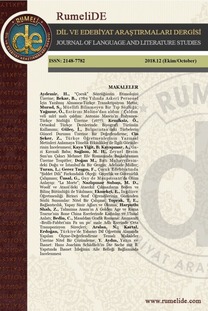Woolf ve Atasü’deki Ataerkil Çıkmazların Beden ve Bilinç Bütünlüğü ile Yıkılması
Beden-bilinç bütünlüğü, yapısöküm, fallosentrik söylem, androjenlik, dişil yazın
Subverting The Double-Bind Situations in Woolf and Atasü Through Body-Mind Unity
___
- Atasü, E. (2009). Bilinçle Beden Arasındaki Uzaklık. İstanbul: Everest. Atasü, E. (2013). A Midlife Dream. England: Milet. Atasü, E. (2014). YAZMAK… ve yaşadığımız yüzyıl…. Günseli Sönmez İşçi (Ed.), Erendiz Atasü Edebiyatı (pp. 32-35). İstanbul: Can. Atasü, E. (n.d.). The Author’s Ideas About Women Fiction. Retrieved from http://www.erendizatasu.com/index.php?id=8 Beauvoir, S. (1989). The Second Sex. H. M. Parshley (Trans.). New York: Vintage Books. Cixous, H. & Clement, C. (1986). The Newly Born Woman. B. Wing (Trans.) Manchester: Manchester University. Foucault, M. (1977). Discipline and Punish: The Birth of the Prison. Alan Sheridan (Trans.) New York: Vintage Books. Frank, F. W. & Treichler, P. A. (1989). Language, Gender, and Professional Writing: Theoretical Approaches and Guidelines for Nonsexist Usage. New York: MLA. Frye, M. (1983). Oppression, in The Politics of Reality. California: The Crossing. Gilbert, S. M. and Gubar, S. (1984). The Madwoman in the Attic: The Woman Writer and the Nineteenth-Century Literary Imagination. London: Yale University. Kristeva, J. (1984). Revolution in Poetic Language. NY: University of Columbia. Lanser, S. S. & Beck, E.T. (1979). The Prism of Sex: Essays in the Sociology of Knowledge. Madison: University of Wisconsin. Matlok-Ziemann, E. (2005). Tomboys, Belles, and Other Ladies: The Female Body-Subject in Selected Works by Katherine Anne Porter and Carson Mc Cullers (Unpublished Doctoral thesis), Uppsala University, Stockholm. Pollock, G. (1988). Vision and Difference: Femininity, Feminism and the Histories of Art. London: Methuen. Rich, A. (2004). (2004). The Moment of Change. USA: Praeger Publishers. Sheldon, A. (1990). Kings Are Royaler Than Queens: Language and Socialization. Young Children, 45 (2), 3-11. Showalter, E. (1979). Toward a Feminist Poetics, Women’s Writing and Writing about Women. London: Groom Helm. Showalter, E. (1981). Feminist Criticism in the Wilderness. Critical Inquiry, 8 (2), 179-205. Stewart, G. (1981). A New Mythos: The Novel of the Artist as Heroine 1877-1977. Montreal: Eden. Tappa, L. (1988). A Protestant Perspective. V. Fabella and M. A. Oduyone (Eds.), With Passion and Compassion: Third World Women Doing Theology (pp. 30-35). NY: Orbis, Maryknoll. Walker, B. B. (1997). Prefiguring the Psychoanalytic Subject. Lily’s Last Stroke: Painting in Process in Virginia Woolf’s To the Lighthouse. Diana F. Gillespie and Leslie K. Hankins (Eds.), Virginia Woolf and The Arts (pp. 32-38). New York: Pace University. Williams, L. (2000). The Artist as Outsider in the Novels of Toni Morrison and Virginia Woolf. Connecticut: Greenwood. Woolf, V. (1929). A Room of One’s Own. New York: Harcourt. Retrieved from http://gutenberg.org Woolf, V. (1979). Women and Fiction. Michele Barrett (Ed.), Women and Writing (pp. 48 – 91) New York: Harcourt. Woolf, V. (1990). To the Lighthouse. USA: HB Classics. Woolf, V. (2000). The Waves. Hertfordshire: Wordsworth.
- ISSN: 2148-7782
- Yayın Aralığı: 6
- Başlangıç: 2014
- Yayıncı: Yakup YILMAZ
Guy de Maupassant’da Ölüm Anlayışı: “La Morte”
Zeynel Besim Sun’un Çakıcı Mehmet Efe Romanında Başkahraman Üzerine Tespitler
Batı Muhayyilesindeki Doğu ve İstanbul’da Bir Gezgin: Adelaide Müller
Ortaokul Türkçe Derslerinde Biyografi Türünün Kullanımı
Çocuk Edebiyatında “Şiddet Dili” Farkındalık Ölçeği: Geçerlik ve Güvenirlik Çalışması
LOKMAN TURAN, Fatma GEREZ TAŞGIN
BİLGE KAYA YİĞİT, AYŞE KAYAPINAR
1789 Yılında Askerî Personel İçin Yazılmış Almanca-Türkçe Transkripsiyon Metni
Müellifi Bilinmeyen Bir Tıp Sözlüğü
Tahmima Anam’ın A Golden Age ve Roma Tearne’nin Bone China Eserlerinde Kadınlar ve Ulusal Anlatı
